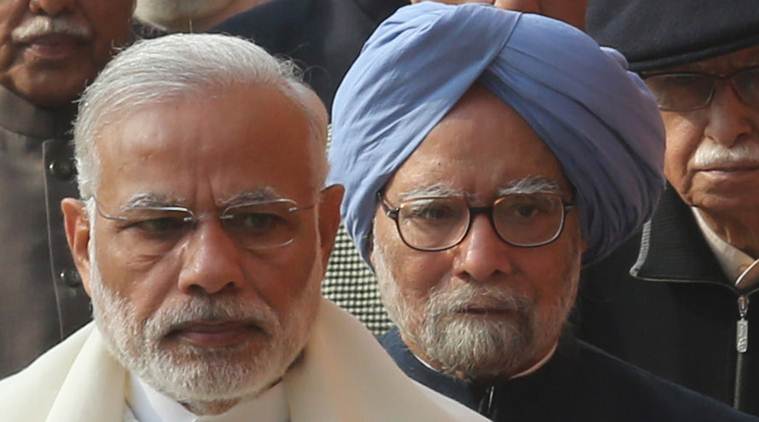The Modi government came to power in 2014 is in its last phase. At this juncture, one ought to make an analysis of the macroeconomic indicators in order to understand the true position of the Indian Economy. As it would be made amply clear over the course of this detailed analysis that the economy was in miserable shape when the NDA government came to power in 2014. The previous finance minister, P. Chidambaram had left behind a tough task for the current finance minister, Jaitley. But it seems that the present government in general and the finance minister in particular has tackled that task in an adroit manner.
Starting with the most obvious macroeconomic indicators, i.e. the GDP growth rate, it stood at a meager 4.7 per cent in 2013-14. In fact, it was for the second year in a row that the Indian economy recorded a subdued economic growth of less than 5 per cent. Despite the opposition’s propaganda, it cannot be denied that under the Modi government the Indian economy has recovered in an unprecedented manner. GDP growth rates for 2017-18 have been estimated at 7.2 per cent. Today, India is the fastest growing economy among all the major economies of the world. One cannot help but laud the way in which the Modi government came at the helm of affairs, took over an economy with a sluggish growth rate and is now about to end its tenure with an impressive GDP growth rate.
Another macroeconomic indicator that stands testimony to the masterful management of the Indian economy under the present government is the fiscal deficit. In the 2014 interim budget presented by the then finance minister, Chidambaram, the fiscal deficit stood at 4.6 percent of the GDP in 2013/14. It must be noted here that Chidambaram had made the job for his successor to keep the fiscal deficit under control exceedingly difficult. Siddhartha Sanyal, who was the Chief India Economist at Barclays at that time had said, “Lower plan expenditure, which accounts for 30 to 35 per cent of the governments overall spending, will have a direct impact on economic growth, future tax collections and fiscal deficit targets.” He had added, “the cut in plan expenditure cant be continued like this.” Thus, with the help of a cut in plan expenditure, Chidambaram had managed to keep the fiscal deficit in control. However, the fiscal deficit was contained in a very superficial manner. This created a very tough situation to manage for Chidambaram’s successor. Despite this, the Modi government has been able to keep fiscal deficit under control throughout its tenure. For 2017-18, the government was able to meet its fiscal deficit target of 3.5 per cent.
Similarly, the Modi government inherited an undesirable inflation rate from the UPA government. While the WPI inflation had stood at 5.2 per cent, CPI inflation was recorded at 9.4 per cent for 2013-14. Inflation is substantially under control under the Modi government. While the CPI inflation today stands at 2.19%, WPI inflation has been recorded at 3.8 per cent.
The foreign exchange reserves have also witnessed a sharp rise under the present dispensation. As of March 28, 2014, the foreign exchange reserves stood at US$ 303.67 billion. As compared to the said position, the foreign exchange reserves stood at $393.287 billion as on December 28, 2018.
A particular challenge that India has been facing for several decades is a low tax to GDP ratio especially when compared to other major economies. Tax to GDP ratio stood at an appallingly low level in 2014. However, with a slew of reforms under the present dispensation, things are changing. Currently, the tax to GDP ratio stands at 17.82 per cent which is indeed a phenomenal achievement. In fact, the direct tax to GDP ratio stands at a 10 year high of 5.98 per cent. This is a major breakthrough for the Modi government visible clearly through macroeconomic indicators . And as per the Tax experts, there are four major reasons behind the exponential rise of the tax to GDP ratio. “Effect of demonetization, proper use of digitally collected information by the tax department, fewer cases of scrutiny, and ease of refunds may be the top four reasons from higher tax collections,” said SP Singh, Partner at Deloitte India. As per the Income Tax data, corporate tax collection registered a 55 percent jump while individual tax collection witnessed 26 percent rise in the last three financial years. Corporate tax collection rose from Rs 32.28 lakh crore to Rs 49.95 lakh and individual tax jumped to Rs 58,576 lakh crore from the previous Rs 46,377 lakh crore. The Modi government has focused on a long neglected area. It has tried widening the tax base in order to strengthen the basics of the Indian economy. If the steady increase in the tax to GDP ratio continues, it will indeed turn out to be a monumental reform for the Indian economy.
Therefore, on a detailed analysis of all major macroeconomic indicators, one can easily observe that the Modi government has been phenomenal in not only taking the Indian ecnomomy out of the miserable situation that it had been left in by the UPA government, but also strengthening the basics of the Indian economy. When the UPA government had ended its 10 year rule in India, the economy was almost in total disarray. What the Modi government has, therefore, managed is nothing less than an unbelievable turnaround.
